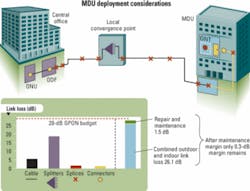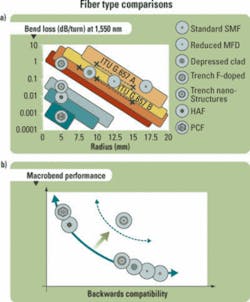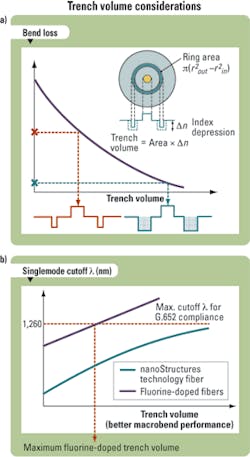by Paulo Dainese, Merrion Edwards, Todd Rhyne, and David Chen
Economic modeling of the business cases for FTTH has revealed that it is most cost effective to concentrate initial deployments in densely populated areas. That fact, coupled with the realization that in such dense areas the majority of subscribers live in multiple dwelling units (MDUs), is driving a strong need for FTTH systems optimized for MDU installations.
The shared experiences of many leading service providers around the world indicate that there are several common goals that must be attained to optimize FTTH deployments to MDUs: reduce up-front installation costs; increase the speed of making a subscriber connection; reduce lifetime operating costs; and maximize the reach, split ratio, and subscriber penetration of the network.
To achieve the first two goals, operators need hardware that increases the speed and ease of inside wiring installation and reduces labor and material costs as well as the number of loss-related rework events during cable installation. In short, the FTTH industry needs optical cables that can be installed and handled in the same robust manner as copper cables.
However, as shown in Fig. 1, optical cables treated in this manner can be subjected to tight bends, compression points in congested ducts, and stapling. Corning and Verizon have investigated the impact of such installation and handling practices and have determined that the optical fiber can see bends down to 5 mm in radius.1 As discussed elsewhere1, fiber macrobend loss of less than 0.1 dB/turn at 5 mm is required to keep the inside wiring total loss at maximum a few tenths of a decibel.
Traditional standard singlemode fibers subjected to one full (360°) turn at a 5-mm bend radius would exhibit a loss in excess of 10 dB (see table). Even a bend-improved fiber compliant to the G.657.A standard would exhibit a loss on the order of several decibels, and a bend-tolerant fiber compliant to the most stringent optical fiber bend standard, G.657.B, would still exhibit high loss in the region of 1 dB.
Truly bend-insensitive fibers exhibit macrobend loss of less than 0.1 dB per turn at 5-mm radius, therefore meeting the requirement for MDU inside wiring. As an example, experimental results for different MDU scenarios and different fiber types are presented in Reference 1. A bend-insensitive fiber in harsh, copper-like installation conditions with tight corners, tension, and staples showed a very small total loss of less than 0.2 dB.
Optimizing the use of the available optical power budget from the central office to the living unit has several advantages; the ability to maximize network reach or increase the split ratio, as two examples, can reduce the overall build costs per subscriber and enable an earlier return on investment. As a consequence, the available optical power budget is a very valuable commodity.
The specific power budget depends on the technology of choice: BPON, GPON, EPON, or RF video overlay. For example, RF video overlay has a loss budget of 26 dB, while in a GPON the maximum available power budget from the central office to the optical network terminal (ONT) is 28 dB. Independent of the specific technology, however, no network operator wants to "waste" budget on inside wiring. The use of a truly bend-insensitive fiber helps them optimize their network design.
As shown in Fig. 2, in the absence of any significant bend events in the indoor cabling, the attenuation from the central office to subscriber can be attributed to attenuation in the cable, the splitters, the splices, and the connectors. By careful choice of quality components to minimize aging losses and environmental variability, the lifetime link loss can be accurately predicted. In this simple example, the total budget of 28 dB is already "used," with only 0.4 dB remaining. Unexpected additional losses due to bend could cause power budget failure or could deplete the repair and maintenance margin, which would significantly increase the risk of optical power budget failure during the network's lifetime. Furthermore, cabling installations in MDUs are more exposed to unwanted public intervention than any other part of the network, which increases the possibility of network outages due to bend events.
Improving the macrobend performance of an optical fiber presents an interesting challenge. There are several fibers designs or technologies that can significantly reduce the macrobend loss. However, a significant challenge is the backwards compatibility requirements imposed by the telecom industry and standards, requirements that severely constrain the design space. In other words, the fiber industry must simultaneously solve the macrobend problem and maintain compatibility with telecom industry requirements. Some conventional designs and more sophisticated fiber technologies are illustrated in Fig. 3a, together with the expected performance given known design constraints. Note that the y-axis is in logarithmic scale, and changing the bend radius by only a few millimeters can change the loss easily by a factor of 10. Therefore, when comparing different fiber technologies, one must pay attention to the specified bend radius.
Splicing such different MFDs would be a challenge too, and one should expect high splice loss. ITU G.652 defines a range for MFD, exactly to avoid incompatibility issues, and that limits the performance improvement one can get with this simple design. All other "conventional" designs, shown in orange tones, have similar limitations; if required to maintain compatibility, they do not deliver the desired performance discussed earlier.
Figure 3b compares the different fiber designs and technologies on a performance versus compatibility chart. Standard singlemode fiber is shown as the reference for both compatibility and performance. On the bottom right is the group of "conventional" designs that use chemical dopants to create modified index profiles. Although these designs exhibit, in general, good compatibility, they have limited gain in performance. Fundamentally, the way light interacts with a chemically doped glass is what limits its performance.
On the top left region of the chart we have specialty fiber technologies, for example, photonic crystal fibers (PCFs) and hole-assisted fibers (HAFs). Figure 3a also shows the expected performance of these technologies. Those designs use air-holes along the fiber length, on the order of a few microns in diameter, to create a structure in the cladding. HAFs and PCFs are functional down to 5-mm bend radii but are not backwards compatible with G.652 fibers or existing field procedures (splicing, connectorization). This drawback, in addition to being incompatible with the large-scale manufacturing processes that are required to deliver fiber volumes suited to mass deployment of FTTH, precludes their widespread use in the FTTH application space.
On the top right is a new fiber technology based on a controlled "nanostructures" ring in the cladding. A commercial bend-insensitive fiber that uses this technology recently has become available; it provides a 10-fold improvement over conventional fiber designs while maintaining backwards compatibility with G.652 standards.
Fundamentally, this technology uses similar physical principles as the specialty PCFs and HAFs but without elevating the cable cutoff wavelength. The way light interacts with a "structured" cladding differentiates these technologies from the more conventional dopant-based designs. In addition, the nanostructures technology is compatible with the same mass-production OVD manufacturing process used for conventional fibers, meeting FTTH volume requirements and exhibiting high manufacturing quality.
Fiber based on this technology can be spliced with any splicing machines, requiring minimal changes to splicing recipes, and are easily processed for connectorization.
Nanostructures fiber is one of the trench fibers illustrated in Fig. 3. The bend performance of a depressed index cladding trench fiber is linked to the "volume" of the trench, where the volume is a multiple of the ring area and the index depression as shown in Fig. 4a. Simply, one can think that the low-index trench acts as a barrier that traps light in the core when the fiber is bent. Increasing the trench "volume" will increase the bend performance, but there is a performance-to-compatibility tradeoff, similar to the
In the case of a structured cladding, the index depression (or trench volume) depends strongly on wavelength; this does not happen with conventional chemical doping. Specifically, the index depression increases with wavelength, supporting macrobending resistance at the more sensitive, long operational wavelengths, and reducing the impact at short wavelengths.
Also, large negative refractive index changes are achievable with a nanostructures technology on a scale that cannot be attained with conventional fluorine doping technology. As a consequence, as shown in Fig. 4b, one can have a greater trench volume and thereby attain a much better bend performance while maintaining low cutoff wavelength, retaining complete backwards compatibility with G.652 standard singlemode fibers.
This advanced macrobend performance brings significant technical and economic benefits to FTTH installations by enabling optical fiber cables that can be handled and installed like copper, with no requirements for avoidance of bends and staples as is the norm for conventional optical fiber cables. Operators avoid significant amounts of installation rework that is caused by bend-induced power loss and associated power budget failure.
1. D.Z. Chen et al., "Requirements for Bend Insensitive Fibers for Verizon's FiOS and FTTH Applications," pres. at NFOEC, paper NTuC2, 2008.
Paulo Dainese is technology assessment manager, new business and technology development, optical fiber, and Merrion Edwards is manager, sales and market development, EMEA, at Corning Incorporated (www.corning.com). Todd Rhyne is senior development engineer, Corning Cable Systems (www.corningcable.com). David Chen is distinguished member of technical staqff at Verizon (www.verizon.com).




